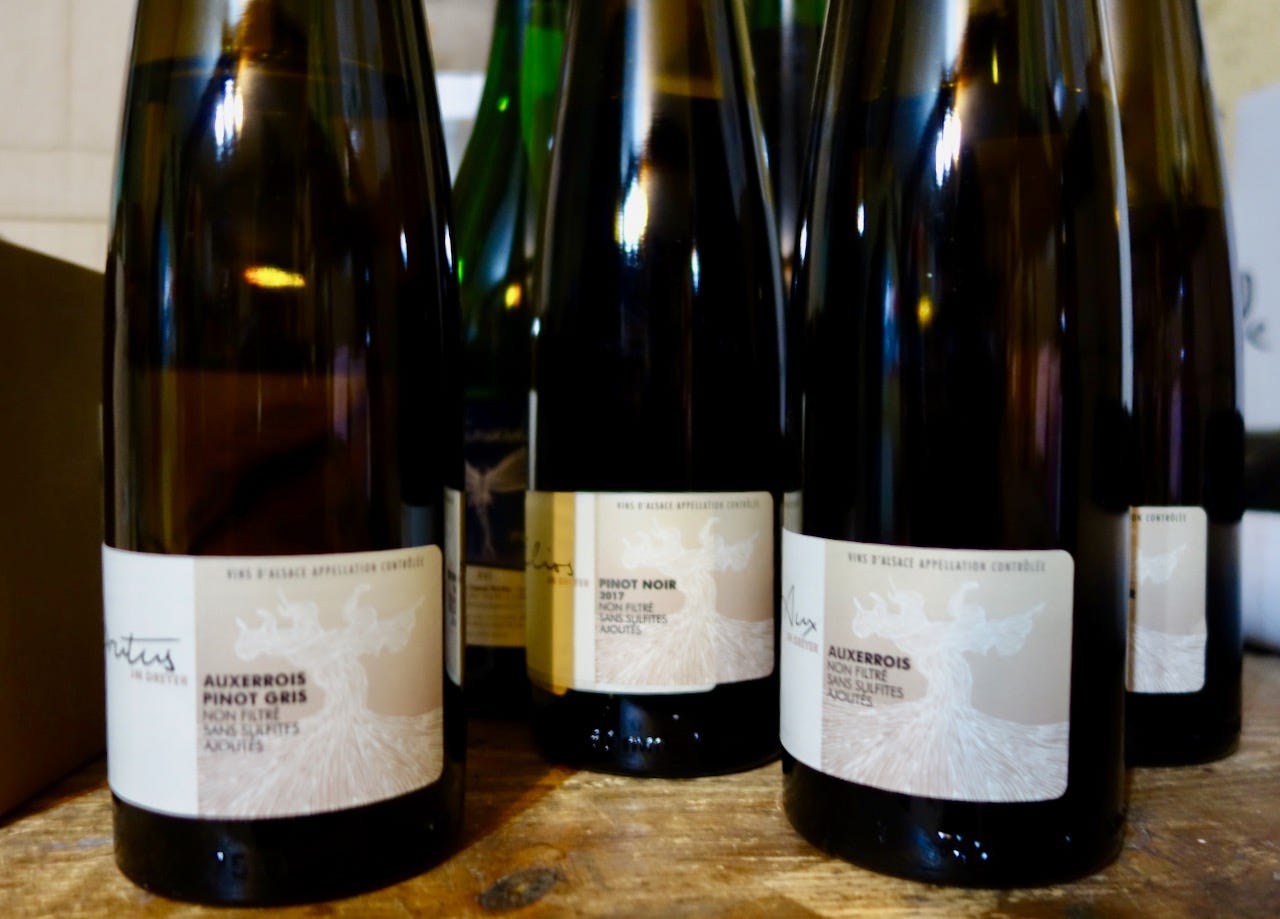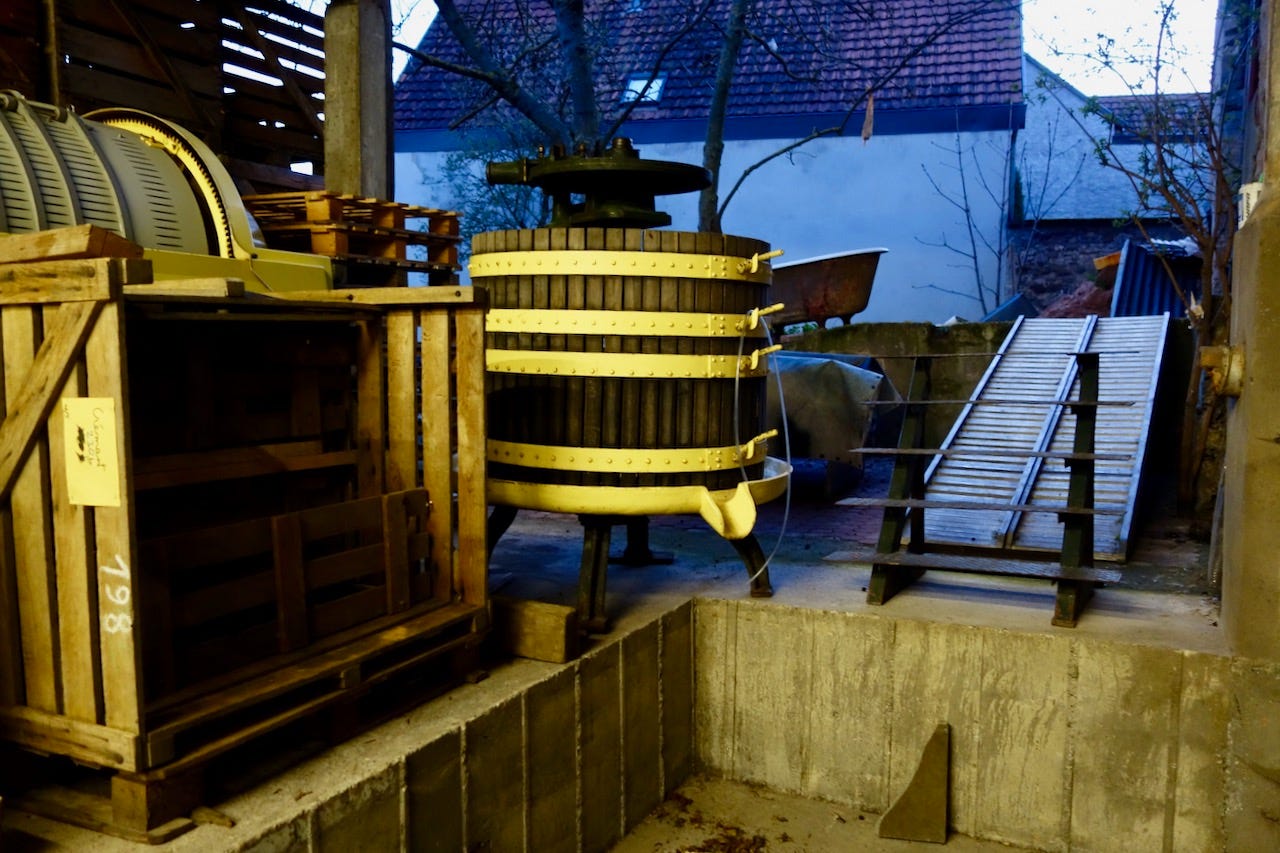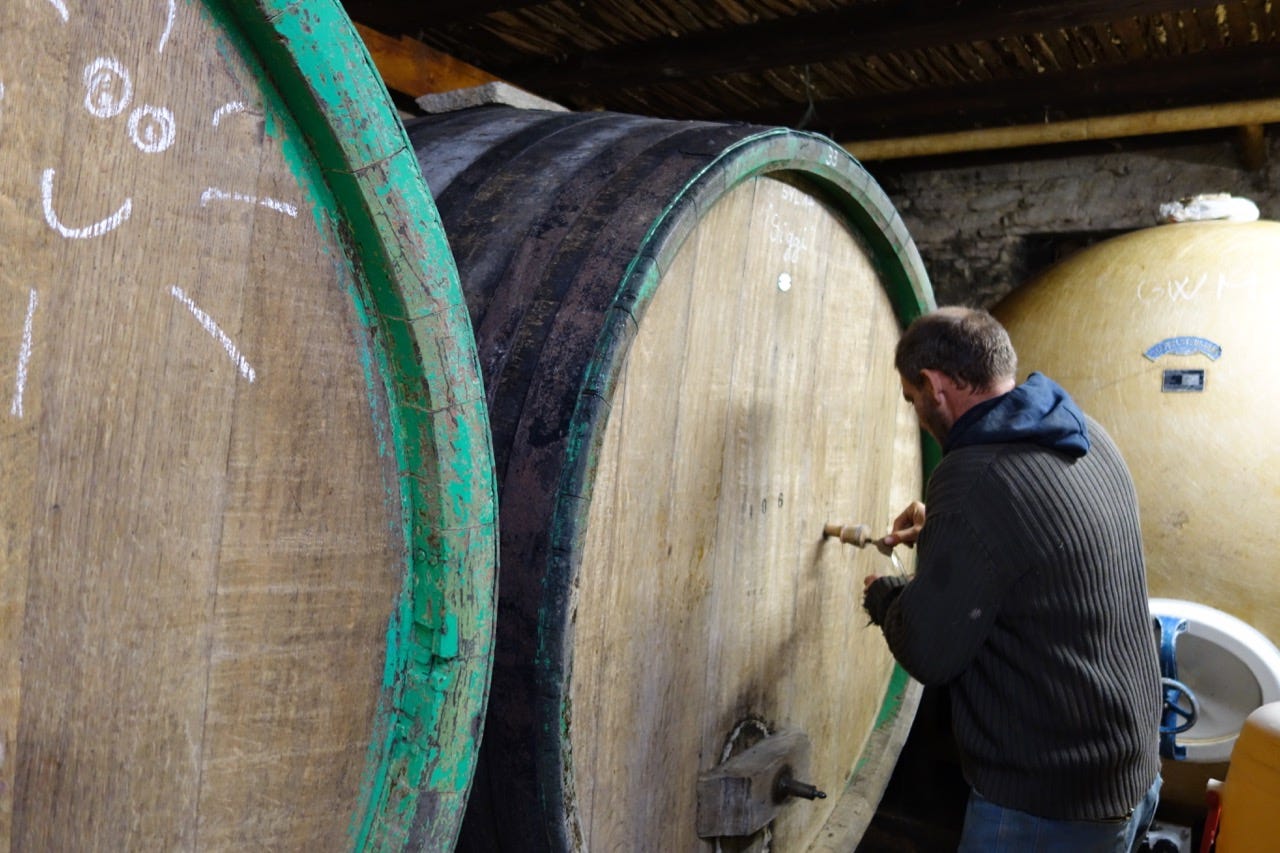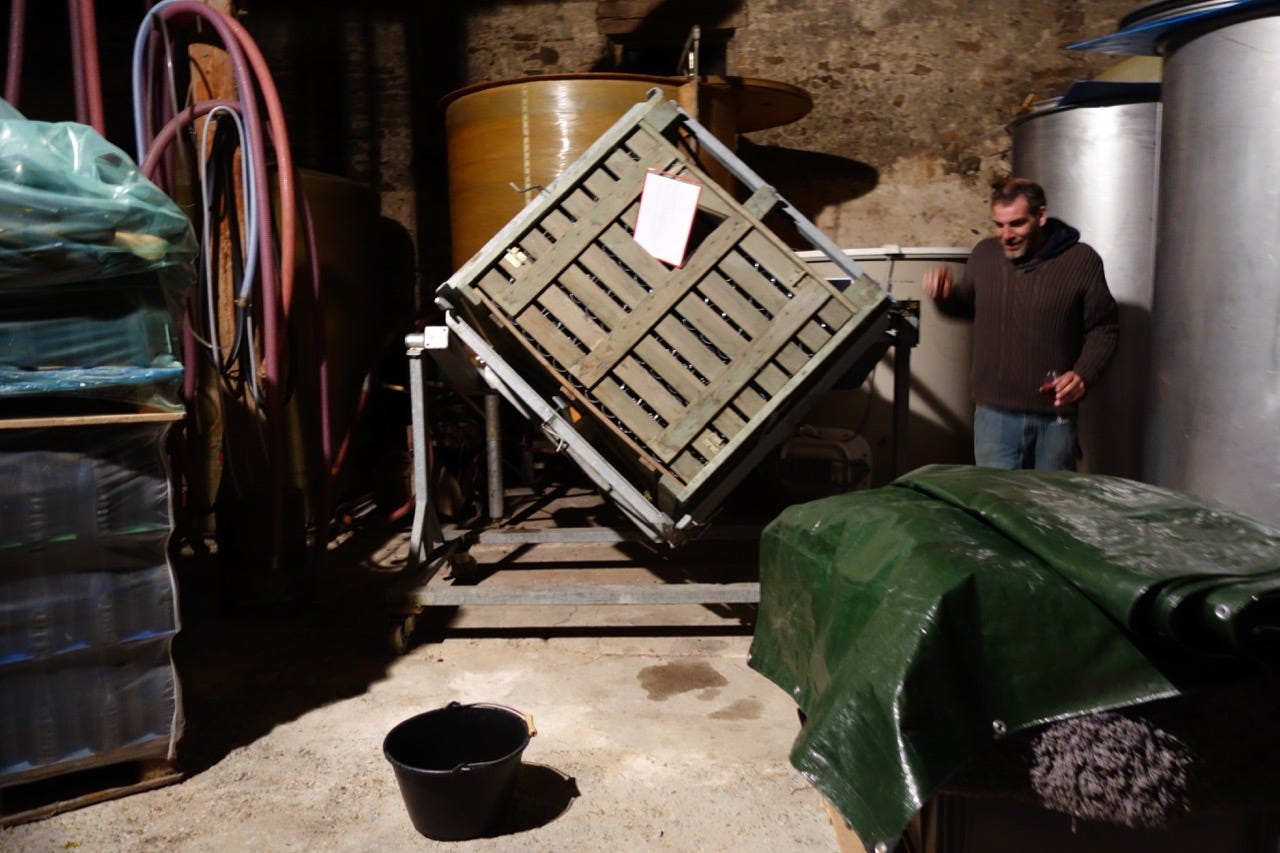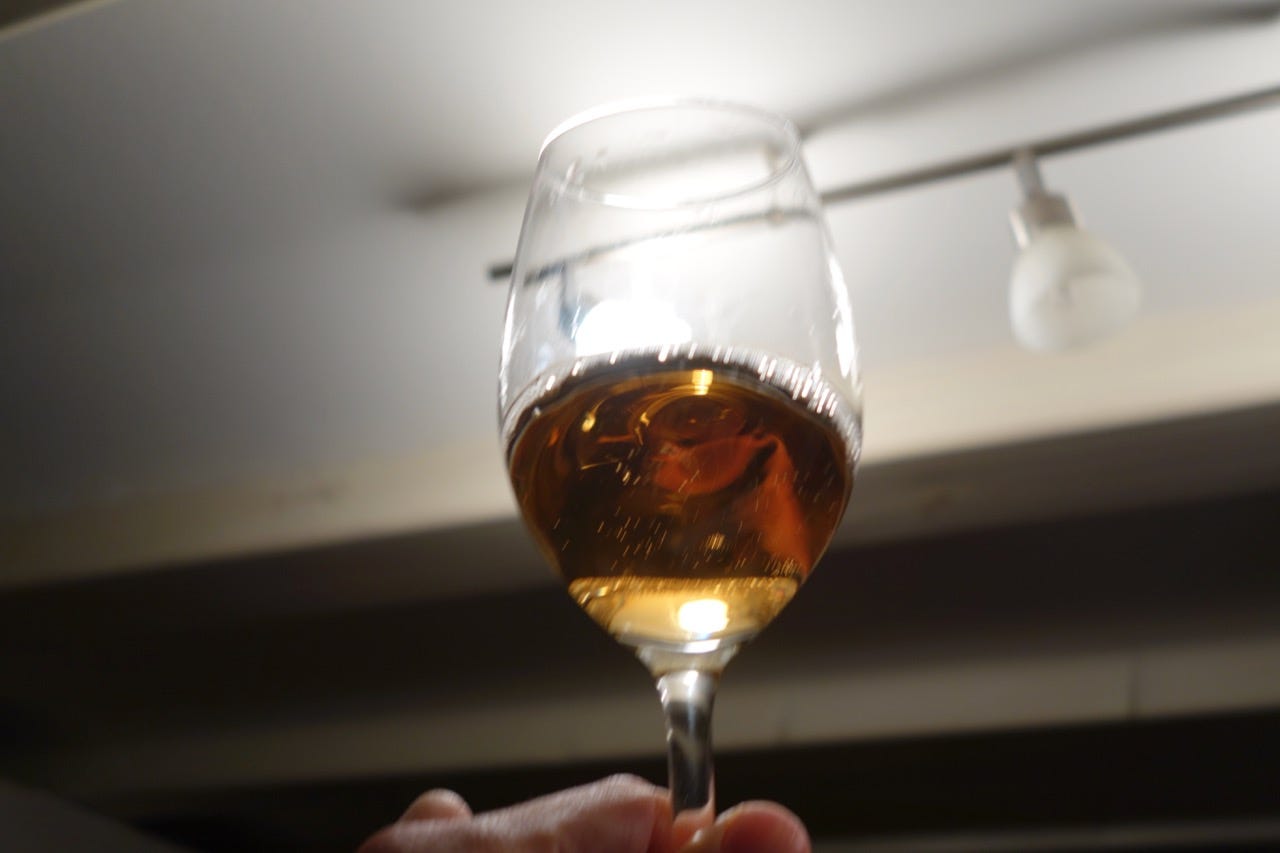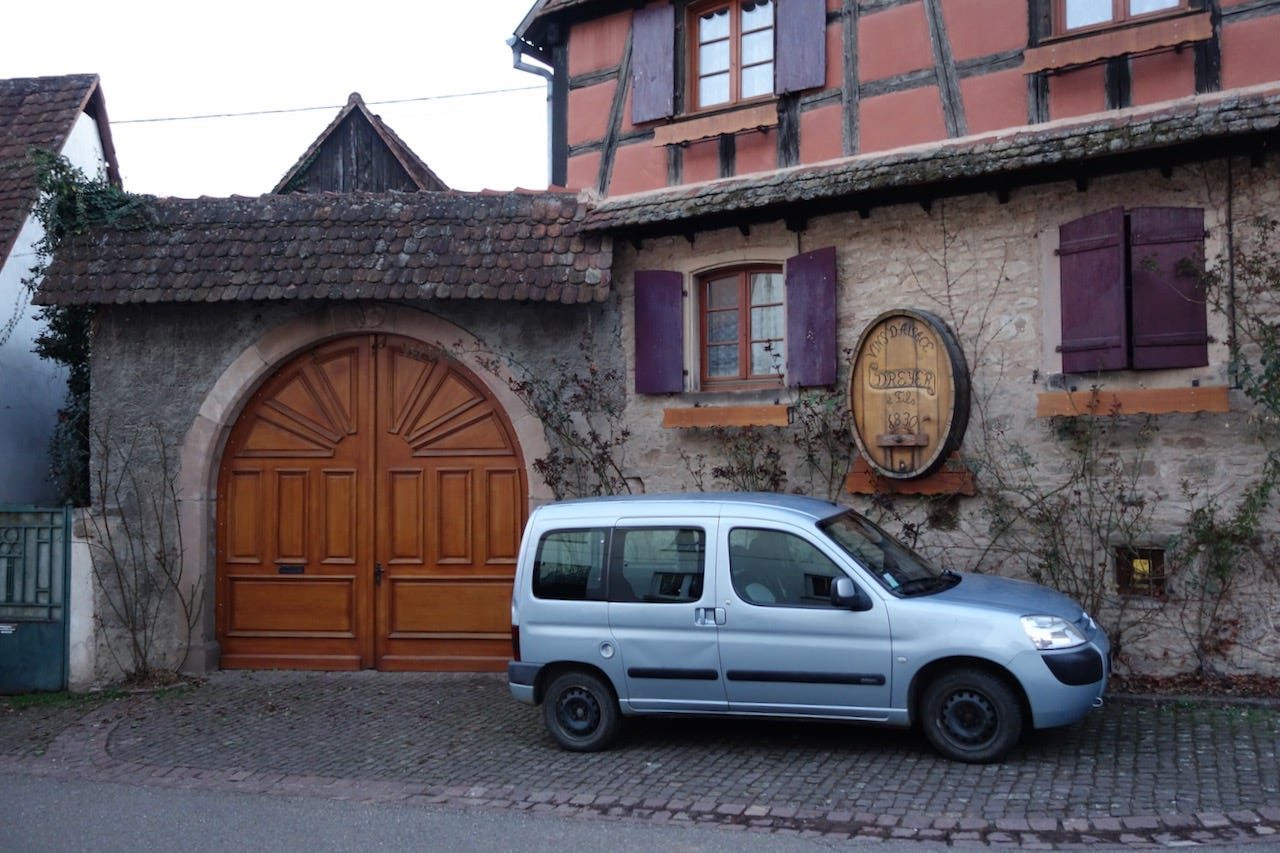ALSACE - Jean-Marc Dreyer, Rosheim
Dreyer cuts a peculiarly affecting figure, resembling mid-career Harrison Ford, if the latter had just returned from a long spirit-quest in the woods.
I first tasted the wines of Jean-Marc Dreyer on a late afternoon in April in the Beaujolais. It was during Romain des Grottes' Beaujalien tasting of unsulfited natural wines, at the moment in late afternoon when the tasting - never a buttoned-down affair to begin with - transitions into a sort of micro-Bonnaroo.
I didn't meet Dreyer himself that day, but I espied his tall Alsatian bottles at his abandoned stand and tasted what I could of the skin-macerated whites that remained in them, intrigued. I later learned Dreyer is a longtime friend and collaborator of recently-established southern Beaujolais natural vigneron Raphael Beysang. The two went to the same viticultural school in Obernai, and worked alongside each other at the domaine of Alsace biodynamic guru Patrick Meyer back in 2003, when Dreyer was an intern and Beysang a cellar hand.
"Now he’s in the Beaujolais," marvels Dreyer affectionately, when I arrive for our tasting this past March at his family's winery in Rosheim. "An Alsatian who went down to the Beaujolais to teach them how to make wine."
Dreyer chuckles, before leaving to fetch glasses. He cuts a peculiarly affecting figure, resembling mid-career Harrison Ford, if the latter had just returned from a long spirit-quest in the woods. Dreyer speaks gently but intensely, in phrases that often drop or become inverted through self-questioning.
He explains that he took a circuitous route to arrive at the style of his present range, which consists of organically-farmed, unfiltered, unsulfited wines, mainly skin-macerated whites.
"I passed through many phases," he says. "When I first came here, I made lots of oaky wines. I bought lots of new barrels and did battonage every day. You didn’t know if it was the wine or wood chips. And then I went through a sugar phase. I had [residual] sugar in all the wines. Now I no longer tolerate sugar."
Dreyer officially took the reins of his father Gérard's domaine in 2004. He made his first crémant without sulfites in 2008, following it with an unsulfited pinot noir soon after. He continued to add 1g / HL to all wines at bottling until 2011.
"I still did a part that was natural and a part of the production that was not natural," he recounts. "Then in 2013 Patrick [Meyer’s] wife, Mireille, she says to me, 'When you’ll get sick of having your ass between two chairs, it’ll go better.'"
That season, Dreyer announced to his father that he wished to forgo sulfite addition entirely. It coincided with a moment of personal reckoning, and in the winter Dreyer arranged to walk the Camino de Saint-Jacques-de-Compostelle, a famous pilgrimage route that took him across France and the north of Spain for three months.
"It changed my life," Dreyer says now. He downplays the religious aspect of the journey, saying instead that it gave him three months to think about why he added sulfur to his wines. "When I came back I said I'll add zero, no more. Now I no longer pose the question. And since I do 100% natural, it’s much faster. It’s more serene in one's head. You don’t even think about it."
The 2018 vintage required some thought, nonetheless. Like many in France, Dreyer did dreamboat yields that year, filling his cellar to the brim. (His vineyard surface is dominated by auxerrois and sylvaner, high-yield varieties, with smaller quantities of pinot gris, gewurztraminer, riesling, muscat d'Alsace, and pinot noir.)
As with many of his neighbours in Alsace, however, fermentations of direct-press whites were troublesome. In March, several such cuvées still had not finished sugars, and showed worrisome volatility.
Dreyer's wine production is somewhat insured against this issue by dint of focusing predominantly on macerated whites, which, thanks to increased exposure to yeasts on skins and stems, tend to ferment more easily.
Dreyer possesses several presses; a pneumatic is used for direct-press wines, while a smaller manual vertical press is used for macerated wines. He suggests that direct-pressing of whites is something that became popular with the advent of electricity and motorized presses, simply due to the outsize labor involved in pressing unmacerated white wines manually.
"When you manage to get the press all the way down, you have to open everything and dig it up and press again. Whereas with maceration when [the press] is done, it’s done," he points out. (The maceration time allows for the grapes to soften and become less resistant to pressing.)
Dreyer's varietal "Origins" cuvées - particularly those from auxerrois, sylvaner, and muscat - are, in recent years, some of the most characterful, saline, and balanced skin-macerated whites of France. They possess the bristling purity of, say, the wines of Savoie orange wine pioneer Jean-Yves Péron, yet with ampler fruit, less extraction, an unforced grace. In 2018, sensing the harvest was less concentrated than usual, Dreyer performed shorter macerations of about ten days, where in earlier years he often took it to between 2-3 weeks.
From barrel and foudre in March everything that saw maceration was already dry, full-fruited, singing. Dreyer notes that usually at that period of the year his wines show more reduction. Interestingly, Dreyer, like fellow Alsace natural vigneron Bruno Schueller, never tops up his barrels, for neither whites nor reds. Most wines develop the voile, without, in most cases, becoming overly marked by oxidative flavours.
"If we want to speak about flaws, we have lots of flaws," Dreyer remarks. "Volatility and things like that. But oxidation, I don’t think it’s a problem for us, because we don’t have it. Or very little. For a wine to oxidise, you really have to go far."
He says that some years, simply due to low yields, he doesn't have enough juice to fill his containers, filling to what would be considered dangerously low levels on certain barrels - without, he says, any issues with oxidation.
Yields on pinot noir have been low in recent years due to mildew. Dreyer produces two versions, both whole-cluster: one aged in foudre entitled "Elios," and another aged in barrel which was formerly called "Anima," but which has evolved, over the last two vintages, into a cuvée he calls "Anigma."
"Guess where the 'G' comes from?" he asks, in a winking reference to his old friend Beysang. "Its a grape. Not gewurztraminer." (Beysang, for his part, has made two cuvées influenced by Dreyer's harvest, which I'll write about sooner or later.)
The 2018 "Anigma" was shimmery and delicious, tasted from barrel in March, possessing a lift not often present in the "Elios," which tends a bit turfier and more rustic in style.
"We're often told reds are to eat with, but we don’t always eat with them. And then we don’t always eat complicated meats every day," he reckons. "You can eat pizza often, and you need an easy wine, without pretension."
Before I depart for dinner in Strasbourg, we move above ground, to the salon where Dreyer hosts his team for meals during harvest. It's still chilly in March; a guest feels the distant after-echo of early mornings in late fall. Dreyer opens some curiosities: a marvelous co-fermented pinot gris - pinot noir blend he calls "Pink Pong," and two unlabeled bottles of experimental skin-macerated, oxidative, long-lees-aged pét'-nat' from 2015, from muscat d'Alsace and auxerrois - pinot gris, respectively.
The muscat still bears the fat of its vintage, but the auxerrois - pinot gris has become something of its own category entirely: a persistent, savoury jolt of electric hazelnut.
One senses it exceeds even its maker's expectations. This, finally, is the wondrous aspect of tasting Dreyer's oeuvre: one feels included in his own mysterious inquiries, in which he accompanies his wines around unlikely corners in search of revelation.
Jean-Marc Dreyer
2 Rue de l'Abattoir
67560 Rosheim
FURTHER READING
On the Gergovie Imports site, Le Saint Europe chef and UK wine importer Harry Lester describes Jean-Marc Dreyer as "one of the nicest people we have ever met."
An account of a visit with Jean-Marc Dreyer at the site of his Australian importer, Living Wines.
A recent profile of Jean-Marc Dreyer at Back in Alsace.
My March visit to Ammerschwihr-based natural négoçiant Farid Yahimi. My December 2018 piece on the use of Flow-Forms chez Christian Binner. My 2018 piece about harvest with Christian Binner in Sprudge Wine.





